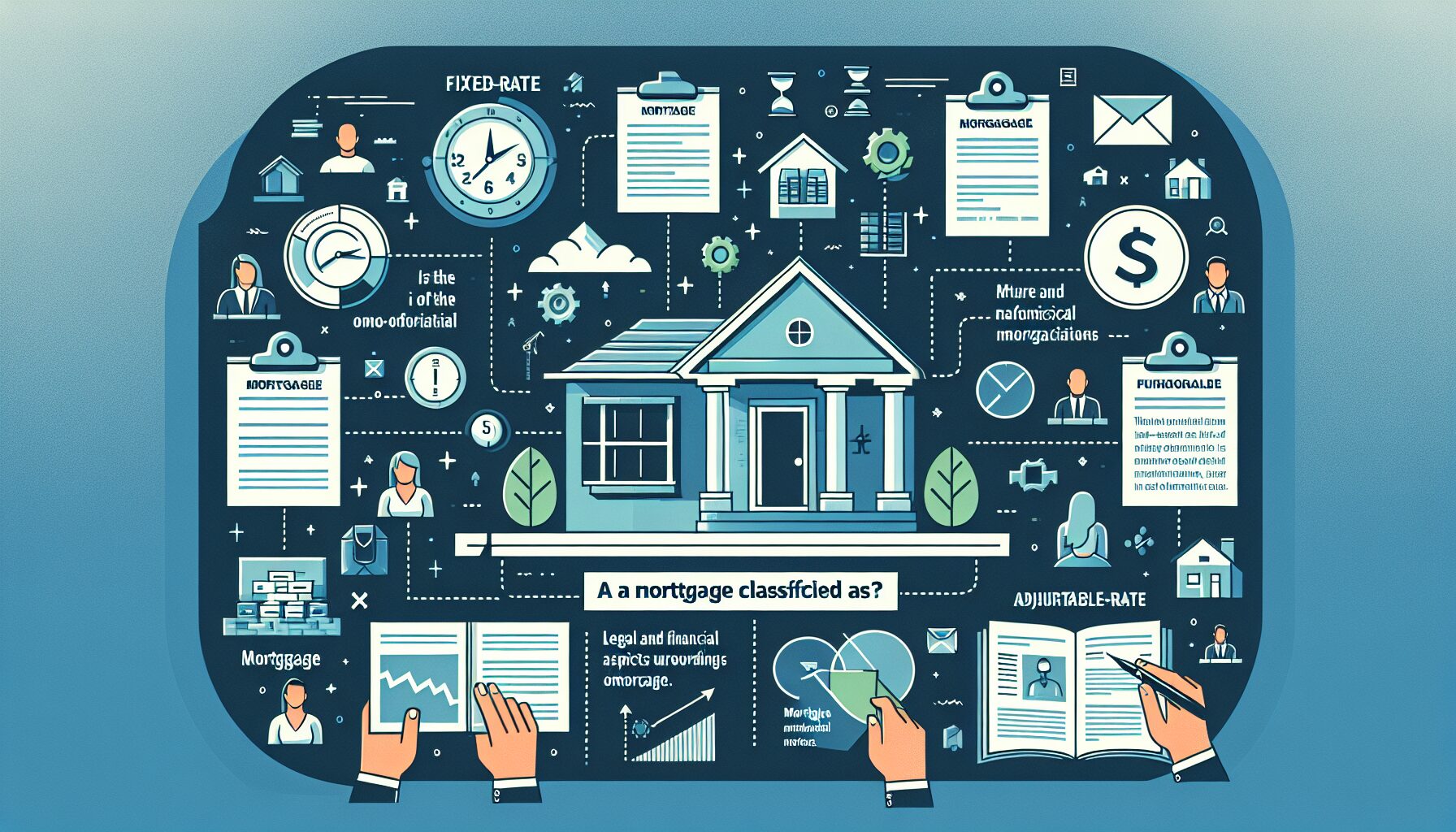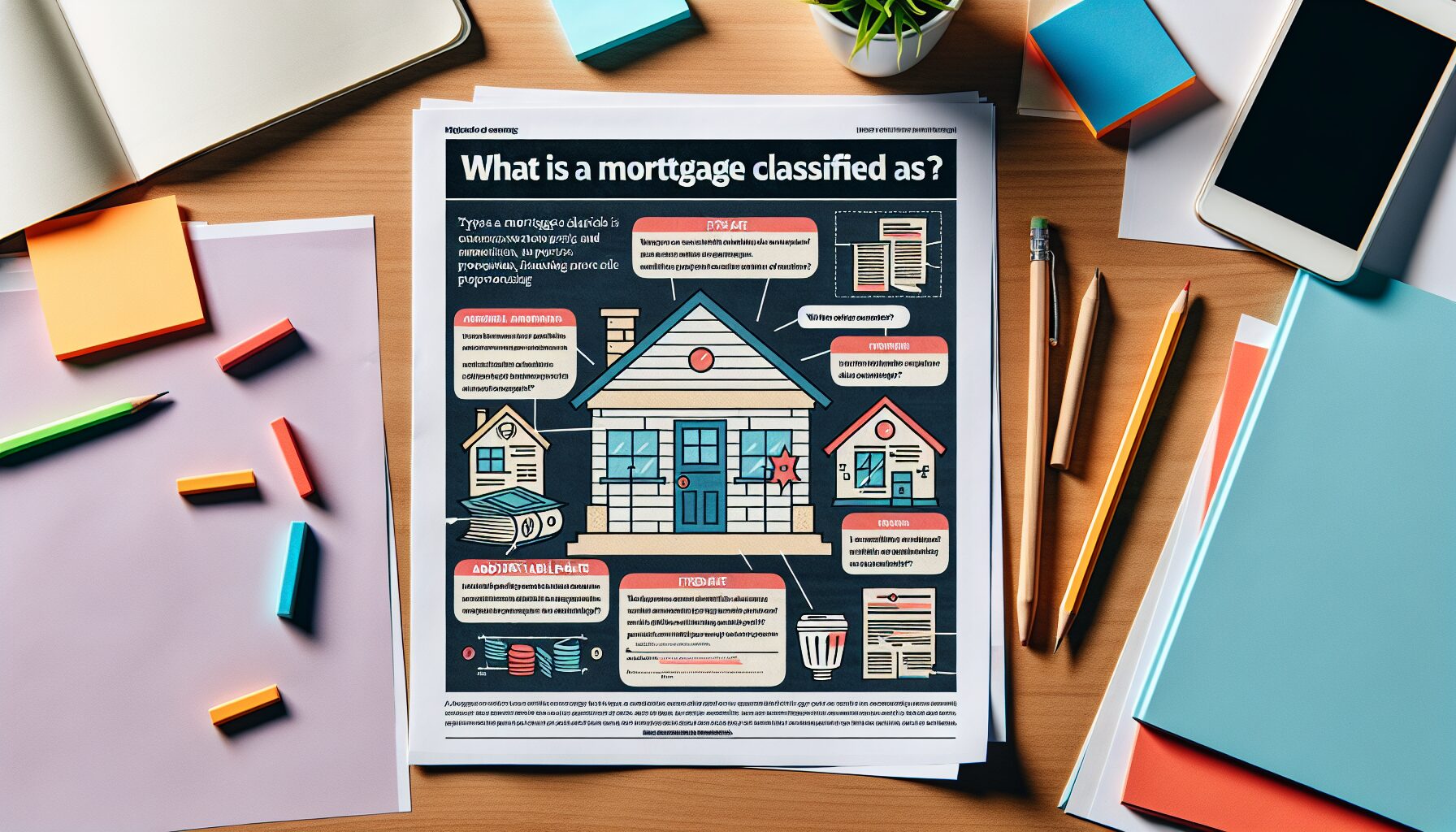
You may have heard the term “mortgage” tossed around in conversations, but have you ever wondered what it is actually classified as? Simply put, a mortgage is a financial agreement that allows you to borrow money from a lender to purchase a property, be it a house, apartment, or even a piece of land. In exchange for this loan, you agree to make monthly payments over a set period of time until the debt is fully repaid. But there’s more to it than just that – let’s explore the intricacies and benefits of mortgages in this article.

Table of Contents
Definition of Mortgage
Defining a Mortgage
A mortgage is a type of loan that is used to finance the purchase of a property, such as a home or a commercial building. It is a financial agreement between a borrower and a lender, typically a bank or a financial institution, where the lender provides the funds needed to buy the property in exchange for the borrower’s promise to repay the loan over a specified period of time, along with interest.
Purpose of a Mortgage
The primary purpose of a mortgage is to enable individuals and businesses to become homeowners or property owners without having to pay the full purchase price upfront. It allows borrowers to spread out the cost of buying a property over an extended period, usually ranging from 15 to 30 years. By obtaining a mortgage, individuals and businesses can afford to make a significant investment in real estate and reap the benefits of property ownership.
Types of Mortgages
Fixed-Rate Mortgage
A fixed-rate mortgage is the most common type of mortgage. With this type of mortgage, the interest rate remains fixed throughout the entire loan term, meaning that the borrower’s monthly mortgage payment remains the same. This stability makes it easier for borrowers to budget and plan their finances, as they know exactly how much they need to pay each month.
Adjustable-Rate Mortgage
Unlike a fixed-rate mortgage, an adjustable-rate mortgage (ARM) has an interest rate that can fluctuate over time. The interest rate is typically fixed for an initial period, such as 5 or 7 years, and then adjusts periodically based on changes in a designated financial index. This type of mortgage is suited for borrowers who anticipate changes in their financial situation or plan to sell the property before the adjustment period begins.
Interest-Only Mortgage
An interest-only mortgage allows borrowers to pay only the interest on the loan for a certain period, typically 5 to 10 years. During this time, the borrower’s monthly payments are significantly lower than those of a traditional mortgage. However, once the interest-only period ends, borrowers are required to start paying both the principal and interest, resulting in higher monthly payments.
Balloon Mortgage
A balloon mortgage is a type of mortgage that offers lower monthly payments for a specified period, often 5 to 7 years, followed by a lump sum payment of the remaining loan balance at the end of the loan term. This type of mortgage is appealing to borrowers who anticipate a large influx of cash or plan to sell the property before the balloon payment is due. However, it is important to carefully consider the ability to make the balloon payment when choosing this type of mortgage.
Government-Backed Mortgages
Government-backed mortgages are loans that are guaranteed or insured by a government agency, such as the Federal Housing Administration (FHA) or the Department of Veterans Affairs (VA). These mortgages are designed to make homeownership more accessible for individuals who may not qualify for conventional mortgages due to lower credit scores or smaller down payment amounts. Government-backed mortgages often have more lenient requirements and offer competitive interest rates.
Components of a Mortgage
Principal
The principal is the original amount of money borrowed from the lender to purchase the property. It represents the actual purchase price of the property and is the amount that needs to be repaid over the duration of the mortgage.
Interest
Interest is the cost of borrowing money from the lender. It is calculated as a percentage of the outstanding loan balance and is added to the monthly mortgage payment. The interest rate can vary depending on the type of mortgage, the borrower’s creditworthiness, and market conditions.
Term
The term of a mortgage refers to the length of time over which the loan must be repaid. It is typically expressed in years, with common mortgage terms ranging from 15 to 30 years. The longer the term, the lower the monthly mortgage payments, but the more interest the borrower will pay over the life of the loan.
Amortization
Amortization is the process of gradually paying off the mortgage loan over time through regular monthly payments. Each payment consists of both principal and interest, with a larger portion going towards interest in the early years of the mortgage and a larger portion going towards the principal in the later years.
Down Payment
The down payment is the initial payment made by the borrower towards the purchase price of the property. It is typically expressed as a percentage of the total purchase price, with common down payment amounts ranging from 3% to 20% of the property’s value. A higher down payment can result in lower monthly mortgage payments and may also help to secure a lower interest rate.
Closing Costs
Closing costs are fees and expenses associated with the purchase of the property that are payable at the closing of the mortgage. These costs can include loan origination fees, appraisal fees, title search and insurance fees, and legal fees. Closing costs are typically a few percentage points of the total loan amount and can vary depending on the location and complexity of the transaction.
Private Mortgage Insurance
Private mortgage insurance (PMI) is a type of insurance that protects the lender in case the borrower defaults on the loan. PMI is generally required for borrowers who make a down payment of less than 20% of the property’s value. The cost of PMI is added to the monthly mortgage payment and can be cancelled once the borrower’s equity in the property reaches a certain threshold, usually 20%.
Mortgage Classification
Real Estate Secured Loan
A mortgage is classified as a real estate secured loan because it is backed by the property being purchased. The property serves as collateral for the loan, meaning that if the borrower fails to make the required mortgage payments, the lender has the right to foreclose on the property and sell it to recover the outstanding balance of the loan.
Debt Instrument
Mortgages are also considered debt instruments because they create a legal obligation for the borrower to repay the loan amount plus interest according to the terms of the mortgage agreement. The mortgage agreement sets out the terms and conditions of the loan, including the interest rate, payment schedule, and any other provisions agreed upon by the lender and borrower.
Lien on Property
A mortgage establishes a lien on the property, which gives the lender the right to claim ownership or sell the property to satisfy the debt if the borrower fails to repay the loan. The lien ensures that the lender has a legal claim to the property until the mortgage is paid off in full.
Secured Debt
A mortgage is a type of secured debt because it is secured by the property being purchased. The property serves as collateral, providing the lender with recourse in case the borrower defaults on the loan. This security allows lenders to offer more favorable terms and lower interest rates compared to unsecured loans.
Residential or Commercial
Mortgages can be classified as either residential or commercial, depending on the type of property being purchased. Residential mortgages are used to finance the purchase of homes or residential properties, while commercial mortgages are used for non-residential properties such as office buildings, retail spaces, or industrial properties.

Legal Considerations
Mortgage Agreement
The mortgage agreement is a legally binding contract between the borrower and lender that sets out the terms and conditions of the loan. It includes details such as the loan amount, interest rate, payment schedule, and any other provisions agreed upon by both parties. It is important for borrowers to carefully review and understand the terms of the mortgage agreement before signing it.
Deed of Trust
In some states, instead of a mortgage agreement, a deed of trust is used to secure the loan. A deed of trust is a legal document that transfers legal title of the property to a trustee who holds it on behalf of the lender until the loan is fully repaid. If the borrower defaults on the loan, the trustee has the authority to initiate foreclosure proceedings on behalf of the lender.
Foreclosure
Foreclosure is the legal process by which the lender takes possession of the property and sells it to recover the outstanding balance of the loan. Foreclosure may occur if the borrower fails to make the required mortgage payments and is in default of the loan. The precise foreclosure procedures and timelines can vary depending on the laws of the jurisdiction in which the property is located.
Property Ownership Rights
When a property is financed through a mortgage, the borrower holds an ownership interest in the property, but the lender also has a security interest in the form of a lien. This means that the borrower has the right to occupy and use the property as their own, subject to the terms of the mortgage agreement, but the lender has the right to foreclose on the property in case of default.
Transfer and Assignment
Mortgages can be transferred or assigned from one lender to another. This transfer or assignment can occur for various reasons, such as when a lender sells its mortgage portfolio or when a borrower refinances their mortgage. The borrower must be notified of any transfer or assignment, and the terms of the mortgage agreement generally remain the same.
Risks and Benefits
Financial Commitment
Taking on a mortgage is a significant financial commitment, as it involves repaying a large sum of money over an extended period. Borrowers should carefully consider their income stability and financial situation before committing to a mortgage to ensure that they can comfortably afford the monthly payments.
Opportunity for Property Ownership
One of the key benefits of a mortgage is the opportunity it provides for individuals and businesses to become homeowners or property owners. Without a mortgage, many people would not be able to afford the upfront cost of purchasing a property, and renting may be the only option. By obtaining a mortgage, individuals and businesses can build equity and potentially benefit from property value appreciation.
Equity Building
As borrowers make monthly mortgage payments, they gradually build equity in the property. Equity refers to the difference between the property’s value and the outstanding balance of the mortgage. Building equity can be seen as a form of forced savings, as borrowers are increasing their ownership stake in the property with each payment.
Tax Benefits
Mortgage interest and property tax payments may be tax-deductible for eligible borrowers. This can provide significant tax savings and reduce the overall cost of homeownership. However, it is important to consult with a tax advisor or accountant to understand the specific tax benefits and eligibility criteria applicable to your situation.
Interest and Mortgage Costs
One of the risks associated with a mortgage is the cost of borrowing, including the interest payments. The interest paid over the life of the loan can significantly increase the total cost of homeownership. Borrowers should carefully consider the interest rate and the impact it will have on their monthly payments and overall financial situation.
Foreclosure Risk
The risk of foreclosure is an important consideration when obtaining a mortgage. If borrowers fail to make their mortgage payments or are in default of the loan, the lender has the right to initiate foreclosure proceedings. Foreclosure can result in the loss of the property and have a negative impact on the borrower’s credit history.
Market Fluctuations
The real estate market is subject to fluctuations, and property values can rise or fall over time. This can affect the value of the property and the borrower’s equity. While property value appreciation can be advantageous for homeowners, a decline in property values can lead to negative equity, where the outstanding mortgage balance exceeds the property’s value.

Mortgage Process
Pre-Approval
Before beginning the search for a property, it is advisable to obtain a pre-approval from a lender. Pre-approval involves a thorough evaluation of the borrower’s financial situation, including income, credit history, and assets. Based on this assessment, the lender determines the maximum loan amount for which the borrower is eligible.
Loan Application
Once pre-approved, the borrower can proceed with the loan application. The loan application requires the borrower to provide detailed financial information, including income, employment history, assets, liabilities, and other relevant information. The lender will use this information to assess the borrower’s creditworthiness and determine whether to approve the loan.
Income and Credit Verification
As part of the mortgage application process, the lender will verify the borrower’s income and credit history. This involves requesting documentation such as pay stubs, W-2 forms, tax returns, and bank statements to confirm the borrower’s income and assets. The lender will also obtain a credit report to assess the borrower’s creditworthiness and repayment history.
Home Appraisal
To ensure that the property being purchased is worth the agreed-upon purchase price, the lender will order a home appraisal. A professional appraiser will evaluate the property’s condition, size, location, and comparable sales in the area to determine its fair market value. The lender uses the appraisal to determine the maximum loan amount it is willing to provide.
Underwriting
Once all the necessary documentation has been submitted, the application goes through the underwriting process. During underwriting, the lender reviews the borrower’s financial information, the appraisal report, and any other relevant documents to assess the borrower’s eligibility for the mortgage. The underwriter may request additional documentation or clarification before making a final decision on the loan.
Closing
If the loan is approved, the borrower proceeds to the closing stage. Closing involves signing the final loan documents and paying any applicable closing costs and fees. The borrower and lender review and sign the mortgage agreement, promissory note, and other legal documents. Once all the documents are signed, the lender funds the loan, and the borrower becomes the official owner of the property.
Mortgage vs. Other Loans
Differences
One key difference between a mortgage and other types of loans is the purpose of the loan. Mortgages are used to finance the purchase of real estate, whereas other loans, such as personal loans or auto loans, are typically used for other purposes, such as debt consolidation or purchasing a vehicle.
Secured vs. Unsecured Loans
Another difference is that mortgages are secured loans, meaning they are backed by collateral, usually the property being purchased. In contrast, other loans, such as personal loans, are often unsecured and do not require collateral. This distinction affects the terms, interest rates, and amount of risk associated with the loan.
Long-Term vs. Short-Term Loans
Mortgages are long-term loans, typically spanning 15 to 30 years, due to the high cost of real estate and the extended repayment period. Other types of loans, like personal loans or short-term loans, have shorter repayment terms, usually a few years or less.
Higher Loan Amounts
Mortgages generally involve higher loan amounts compared to other types of loans. This is because real estate is a significant investment, and the cost of purchasing a property is typically much higher than the cost of buying a car or paying for a vacation.
Specific Purpose
Mortgages have a specific purpose, which is to finance the purchase of a property. Other loans, such as personal loans, allow borrowers to use the funds for various purposes, such as home renovations, education expenses, or debt consolidation.

Mortgage Industry
Key Players
The mortgage industry encompasses a wide range of participants, including borrowers, lenders, mortgage brokers, real estate agents, appraisers, and title companies. Each plays a crucial role in facilitating the mortgage process and ensuring its smooth operation.
Roles and Responsibilities
Borrowers are responsible for submitting accurate and complete mortgage applications, providing necessary documentation, and making timely mortgage payments. Lenders evaluate borrower eligibility, fund the loan, and manage the mortgage throughout its term. Mortgage brokers assist borrowers in finding suitable lenders and mortgage products. Real estate agents help buyers and sellers navigate the property purchase process. Appraisers determine the fair market value of the property. Title companies handle the legal aspects of the property transfer and ensure the lender’s security interest.
Mortgage Brokers vs. Direct Lenders
Mortgage brokers act as intermediaries between borrowers and lenders. They work with multiple lenders to match borrowers with suitable mortgage options. In contrast, direct lenders are financial institutions that lend their own money and make the final decision on whether to approve a loan. Both mortgage brokers and direct lenders play key roles in the mortgage industry and offer distinct advantages depending on the borrower’s needs.
Market Trends
The mortgage industry is influenced by various market trends, including interest rates, housing market conditions, and government policies. Interest rates directly affect borrowing costs and determine the affordability of a mortgage. Housing market conditions can impact property prices, buyer demand, and the availability of mortgage financing. Government policies, such as tax incentives or changes to lending regulations, can affect the overall mortgage landscape.
Regulatory Environment
The mortgage industry is subject to extensive regulation to protect borrowers and ensure fair lending practices. Various regulatory bodies, such as the Consumer Financial Protection Bureau (CFPB) and state regulatory agencies, oversee mortgage lending activities. These regulations aim to promote transparency and prevent predatory lending practices that could harm borrowers.
Common Terms in Mortgages
Principal and Interest
The principal is the original loan amount borrowed from the lender, while the interest is the cost of borrowing the money. Each monthly mortgage payment typically consists of both principal and interest, with a portion going towards repaying the loan balance and a portion going towards interest charges.
Annual Percentage Rate (APR)
The annual percentage rate (APR) is a measure of the total cost of borrowing, expressed as an annual rate. The APR includes not only the interest rate but also any other fees or charges associated with the mortgage, such as origination fees or discount points. It provides borrowers with a way to compare the true cost of different mortgage offers.
Loan-to-Value Ratio (LTV)
The loan-to-value ratio (LTV) is the ratio of the loan amount to the appraised value of the property. It is a measure of the riskiness of the mortgage from the lender’s perspective. A higher LTV indicates a greater risk for the lender, as the borrower has less equity in the property. Lenders often have maximum LTV requirements for different mortgage programs.
Escrow
Escrow is an account that holds funds, typically maintained by the lender, to pay for taxes and insurance associated with the property. It ensures that these expenses are paid timely and that the property remains protected. Each monthly mortgage payment may include an additional amount to cover these escrow expenses.
Points
Points, also known as discount points, are fees paid by the borrower to the lender at closing in exchange for a lower interest rate. Each point typically represents 1% of the loan amount and can result in a reduced interest rate over the life of the loan. Paying points upfront can be advantageous for borrowers who plan to stay in the property for an extended period.
Credit Score
A credit score is a numerical representation of an individual’s creditworthiness. It is based on factors such as payment history, credit utilization, length of credit history, and credit mix. Lenders use credit scores to assess the borrower’s risk and determine the interest rate and terms of the mortgage. A higher credit score generally results in more favorable mortgage terms.
Refinancing
Refinancing involves obtaining a new mortgage to replace an existing one. Borrowers may choose to refinance to take advantage of lower interest rates, reduce their monthly payments, change the loan term, or access the equity in their property. Refinancing requires going through the mortgage application process again, including credit and income verification.
Prepayment Penalty
A prepayment penalty is a fee charged to borrowers who repay their mortgage before a specified period, usually within the first few years of the loan term. The purpose of a prepayment penalty is to compensate the lender for potential lost interest income. Prepayment penalties are not common and should be carefully considered before choosing a mortgage.








